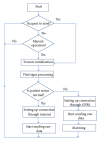A wireless emergency telemedicine system for patients monitoring and diagnosis
- PMID: 24883059
- PMCID: PMC4026975
- DOI: 10.1155/2014/380787
A wireless emergency telemedicine system for patients monitoring and diagnosis
Abstract
Recently, remote healthcare systems have received increasing attention in the last decade, explaining why intelligent systems with physiology signal monitoring for e-health care are an emerging area of development. Therefore, this study adopts a system which includes continuous collection and evaluation of multiple vital signs, long-term healthcare, and a cellular connection to a medical center in emergency case and it transfers all acquired raw data by the internet in normal case. The proposed system can continuously acquire four different physiological signs, for example, ECG, SpO2, temperature, and blood pressure and further relayed them to an intelligent data analysis scheme to diagnose abnormal pulses for exploring potential chronic diseases. The proposed system also has a friendly web-based interface for medical staff to observe immediate pulse signals for remote treatment. Once abnormal event happened or the request to real-time display vital signs is confirmed, all physiological signs will be immediately transmitted to remote medical server through both cellular networks and internet. Also data can be transmitted to a family member's mobile phone or doctor's phone through GPRS. A prototype of such system has been successfully developed and implemented, which will offer high standard of healthcare with a major reduction in cost for our society.
Figures
















Similar articles
-
A mobile care system with alert mechanism.IEEE Trans Inf Technol Biomed. 2007 Sep;11(5):507-17. doi: 10.1109/titb.2006.888701. IEEE Trans Inf Technol Biomed. 2007. PMID: 17912967
-
A telemedicine system for wireless home healthcare based on Bluetooth and the Internet.Telemed J E Health. 2004;10 Suppl 2:S-110-6. Telemed J E Health. 2004. PMID: 23570221 Clinical Trial.
-
An intelligent telecardiology system using a wearable and wireless ECG to detect atrial fibrillation.IEEE Trans Inf Technol Biomed. 2010 May;14(3):726-33. doi: 10.1109/TITB.2010.2047401. Epub 2010 Apr 5. IEEE Trans Inf Technol Biomed. 2010. PMID: 20371411
-
Smart Home-based IoT for Real-time and Secure Remote Health Monitoring of Triage and Priority System using Body Sensors: Multi-driven Systematic Review.J Med Syst. 2019 Jan 15;43(3):42. doi: 10.1007/s10916-019-1158-z. J Med Syst. 2019. PMID: 30648217
-
Real-Time Remote Health Monitoring Systems Using Body Sensor Information and Finger Vein Biometric Verification: A Multi-Layer Systematic Review.J Med Syst. 2018 Oct 16;42(12):238. doi: 10.1007/s10916-018-1104-5. J Med Syst. 2018. PMID: 30327939
Cited by
-
Transformative Innovations in Reproductive, Maternal, Newborn, and Child Health over the Next 20 Years.PLoS Med. 2016 Mar 2;13(3):e1001969. doi: 10.1371/journal.pmed.1001969. eCollection 2016 Mar. PLoS Med. 2016. PMID: 26933951 Free PMC article. Review.
-
Diagnostic Accuracy Comparison of Artificial Immune Algorithms for Primary Headaches.Comput Math Methods Med. 2015;2015:465192. doi: 10.1155/2015/465192. Epub 2015 May 4. Comput Math Methods Med. 2015. PMID: 26075014 Free PMC article.
-
Chemical polarization effects of electromagnetic field radiation from the novel 5G network deployment at ultra high frequency.Health Technol (Berl). 2021;11(2):305-317. doi: 10.1007/s12553-020-00501-x. Epub 2021 Jan 27. Health Technol (Berl). 2021. PMID: 33527067 Free PMC article.
-
Integration of 5G and Block-Chain Technologies in Smart Telemedicine Using IoT.J Healthc Eng. 2021 Mar 22;2021:8814364. doi: 10.1155/2021/8814364. eCollection 2021. J Healthc Eng. 2021. PMID: 33824715 Free PMC article.
-
Cost-effective vital signs monitoring system for COVID-19 patients in smart hospital.Health Technol (Berl). 2022;12(1):239-253. doi: 10.1007/s12553-021-00621-y. Epub 2021 Nov 12. Health Technol (Berl). 2022. PMID: 34786323 Free PMC article.
References
-
- Pavlopoulos S, Istepanian RH, Laxminarayan S, Pattichis CS. Emergency health care systems and services: section overview. Proceedings of the 5th International IEEE EMBS Special Topic Conference on Information Technology Applications in Biomedicine; 2006; pp. 371–374.
-
- Anta R, El-Wahab S, Giuffrida A. Mobile Health: The potential of Mobile Telephony to Bring Health Care to the Majority. Inter-American Development Bank; 2009.
-
- Wyne MF, Vitla VK, Raougari PR, Syed AG. Remote patient monitoring using GSM and GPS technologies. Journal of Computing Sciences in Colleges. 2009;24(4):189–195.
-
- Hande A, Polk T, Walker W, Bhatia D. Self-powered wireless sensor networks for remote patient monitoring in hospitals. Sensors. 2006;6(9):1102–1117.
LinkOut - more resources
Full Text Sources
Other Literature Sources

